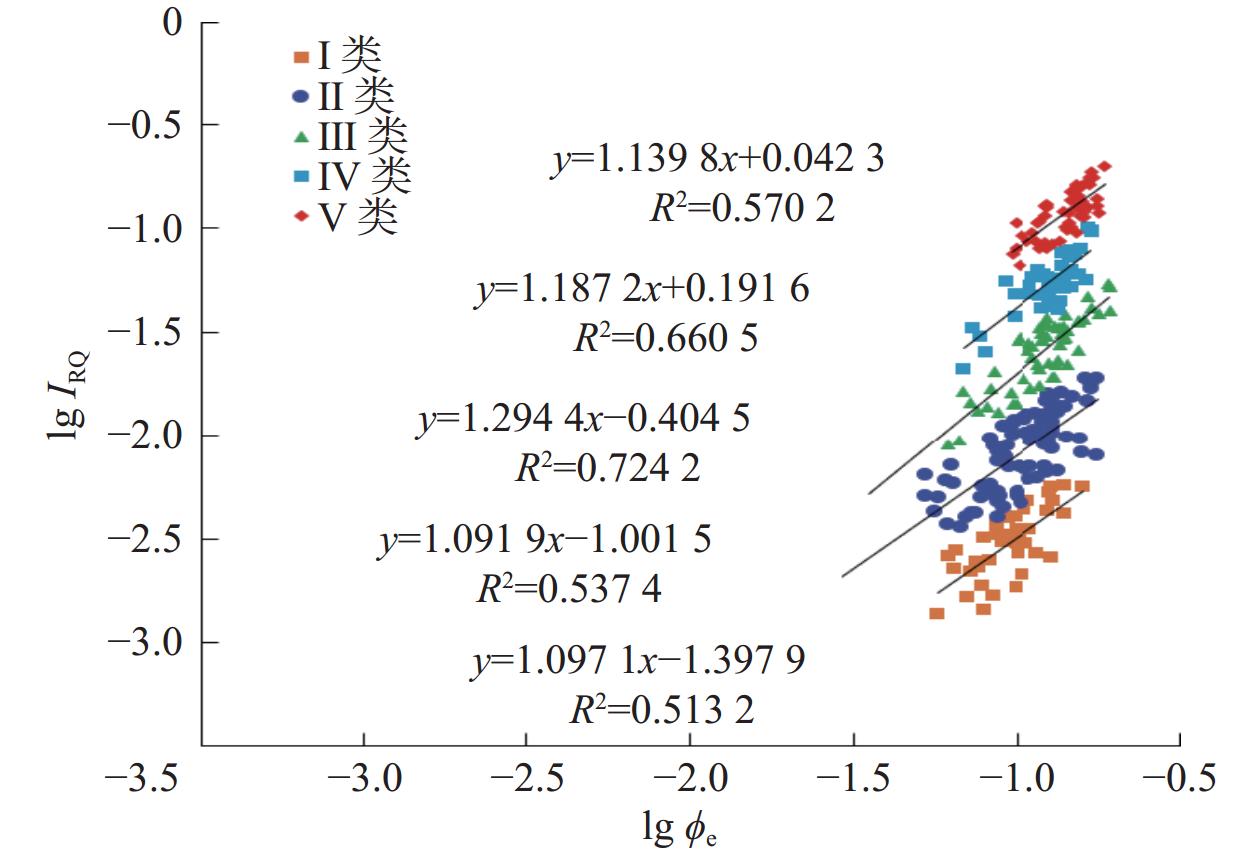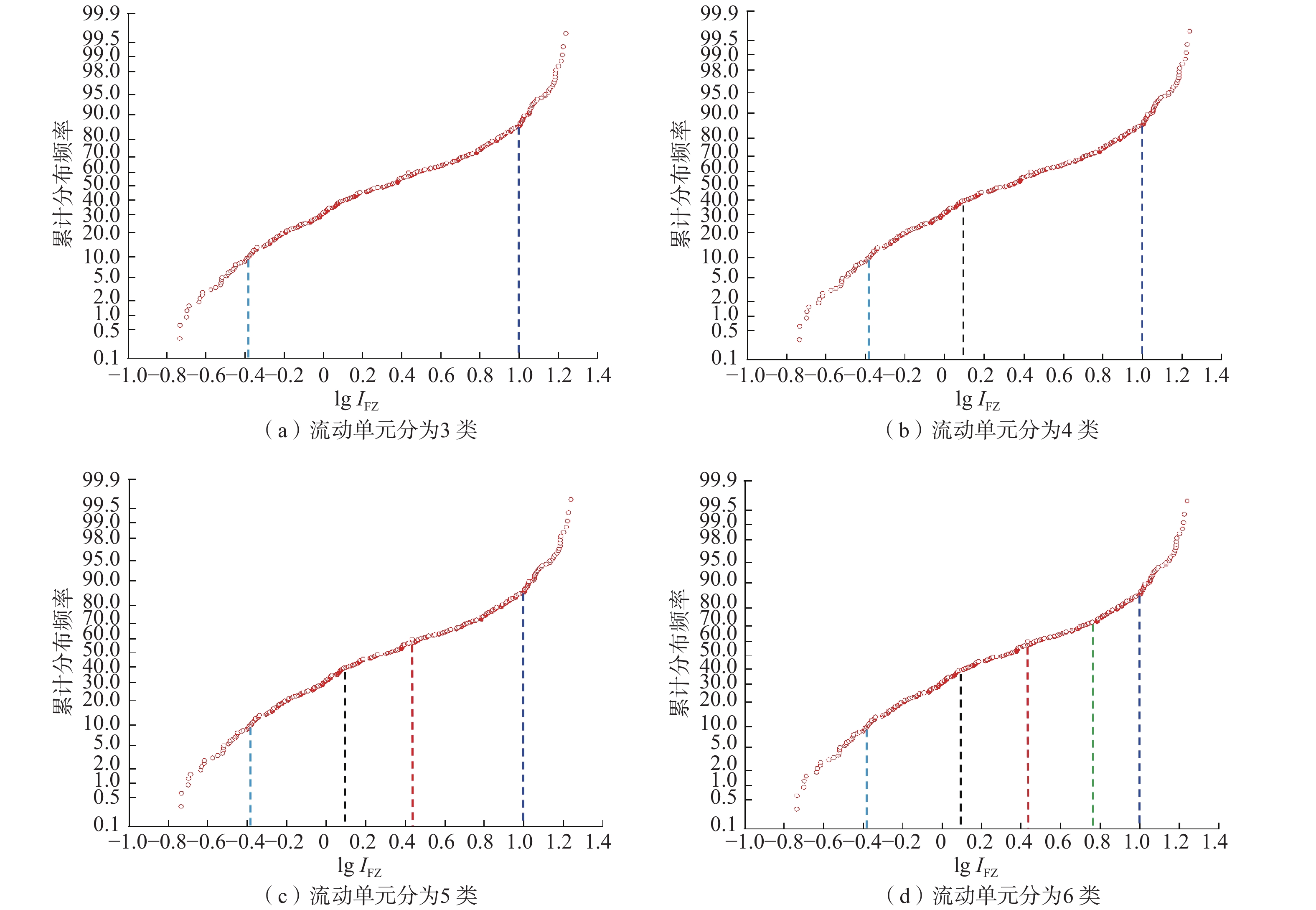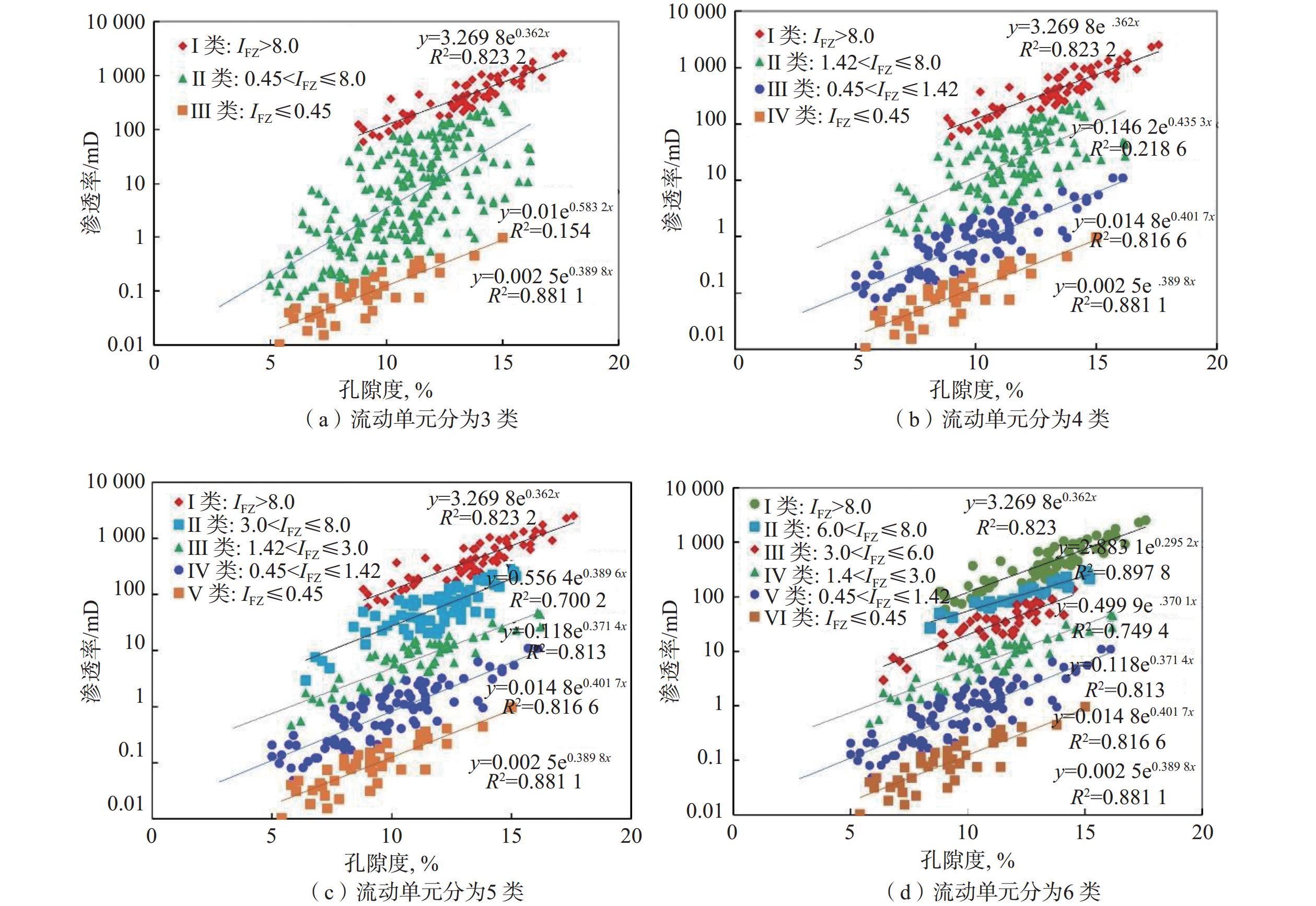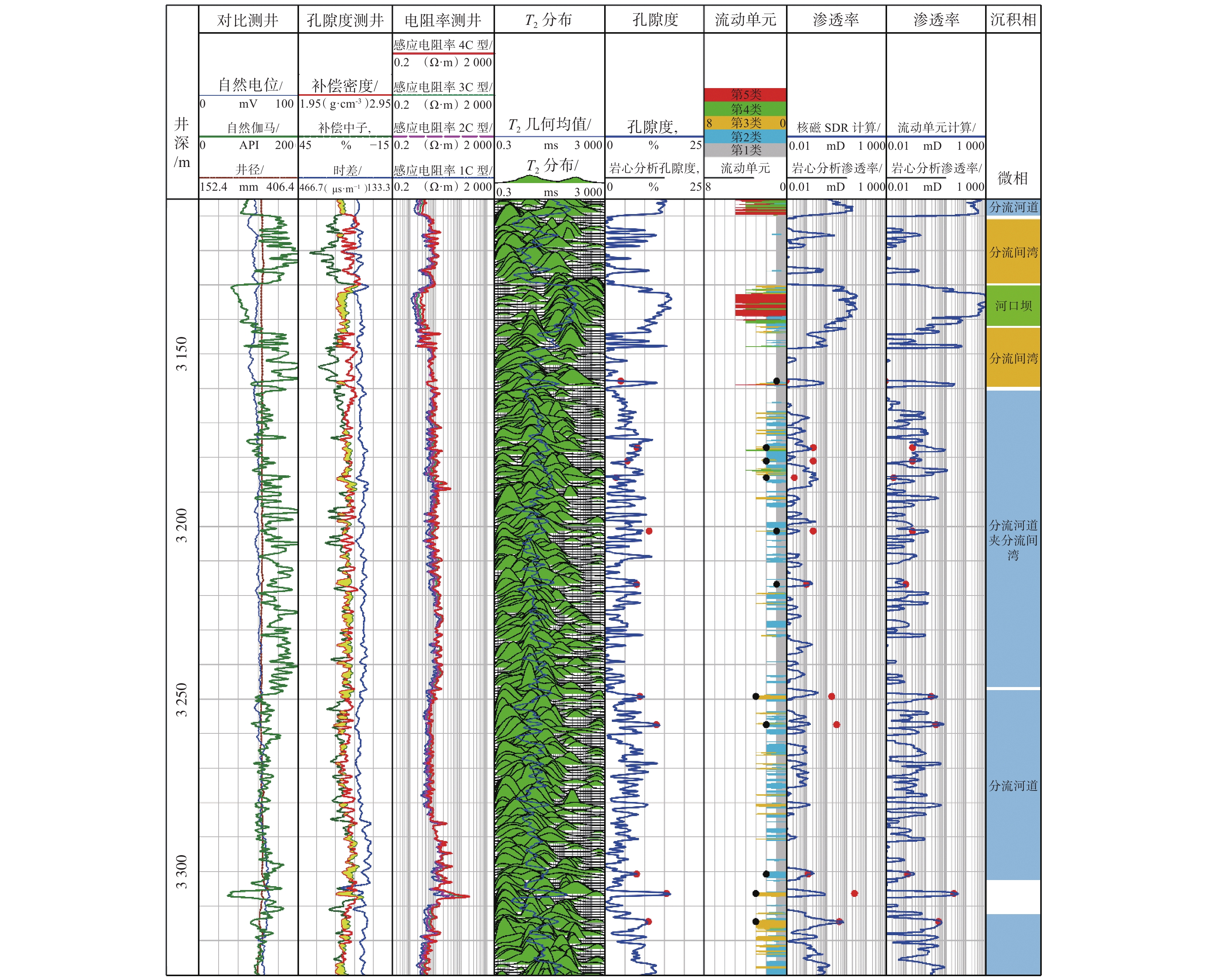Permeability Evaluation from Logs based on Classification and Optimization of Flow Unit in Tight Sandstone
-
摘要:
致密砂岩储层的非均质性强,常规测井解释模型没有考虑储层纵向上的渗流特征差异性,导致渗透率解释精度低。为此,采用储层流动单元描述致密砂岩储层非均质特征,建立了具有不同渗流单元的渗透率解释模型,以提高渗透率预测精度。首先,结合岩心实验流动单元指数频数分布与累计分布频率,建立流动单元分类标准,并优选流动单元分类数目,分类构建渗透率模型;然后,引入深度神经网络,结合常规测井和核磁测井数据,预测流动单元指数;最后,基于分类渗透率解释模型,计算储层渗透率。珠江口盆地惠州凹陷古近系恩平组应用该渗透率计算方法进行计算,流动单元分为5类最佳,测井尺度的流动单元识别分类与沉积相具有较好地一致性,渗透率计算准确度相比核磁模型明显提高。研究结果为深层致密砂岩储层渗透率评价提供了新的计算方法。
Abstract:Conventional log interpretation models usually overlook the longitudinal flow properties due to the heterogeneity of tight sandstone reservoirs, leading to low accuracy in permeability interpretation. Therefore, the flow units (FU) are utilized to describe the heterogeneity characteristics of tight sandstone reservoirs. Constructing permeability models of different FU are expected to improve the evaluation accuracy of permeability. In this study, the flow unit classification standard is established by combining the frequency distribution histogram and cumulative probability plot of experimental Flow Zone Indicator (IFZ), and the optimal number of flow unit is selected to establish multiple permeability models. Additionally, the deep neural network (DNN) is introduced to predict IFZ by combining conventional logging and nuclear magnetic resonance (NMR) logging data. Finally, well permeability is calculated based on multiple permeability interpretation models. This permeability calculation method is applied to Paleogene Enping Formation in HuiZhou depression, Pearl River Mouth Basin, and five FU types are selected to optimal classification. The application result shows that the predicted FU types are well aligned with sedimentary facies and the accuracy of permeability calculations has significantly improved compared to NMR model. Overall, the permeability calculation method based on classification and optimization of FU provides a new insight for accurate evaluation of logging permeability in deep tight sandstone reservoirs.
-
Keywords:
- tight sandstone /
- permeability evaluation /
- flow unit /
- deep learning
-
致密砂岩储层属于非常规油气储集层[1–3],沉积过程中受到多种沉积作用的影响,储层非均质性强,孔隙结构复杂,孔喉微小,在同一孔隙度下储层的渗透率相差1~4个数量级,渗透率测井解释与准确预测是一项具有挑战性的研究工作[4–6]。
目前,储层渗透率计算方法主要有统计学方法和机器学习方法。统计学方法为基于岩心实验数据的经验统计模型和半经验半物理模型,常用模型包括指数模型、幂律模型[7]、Kozeny-Carman模型[8–9]、Timur模型[10]和SDR模型[11]等,但统计学方法得到的渗透率结果通常与实际测试存在偏差,且无法充分描述致密砂岩储层渗流规律与复杂孔喉结构之间的关系[12–13]。渗透率预测也可以采用机器学习方法,目前性能较好的机器学习模型主要有支持向量机[14]、随机森林 [15–16]和XGBoost[17]等。但是,浅层机器学习的结构单一,组合之后更是将各自的缺点叠加,如泛化能力受到制约,在渗透率预测中具有局限性。引入复杂的机器学习模型,如卷积神经网络[18]、循环神经网络[19]等,可以适应复杂的储集特征、地质沉积特征,以建立渗透率与测井参加数据间复杂的非线性映射关系。致密砂岩储层非均质性强,孔隙结构复杂,仅依靠机器学习模型直接预测渗透率难以取得较好的效果,对储层分类评价是描述储集层非均质性和渗流特征的有效途径。引入流动单元,将储层划分多类具有不同渗流特性的流动单元,采用流动单元指数作为流动单元划分的指标,建立多类流动单元下的渗透率测井解释模型,以提高渗透率准确性 [20–25]。现有的流动单元指数预测方法包括多元回归法[26]、Fisher判别法[26]和机器学习法[27]。对于致密砂岩储层,流动单元指数与测井响应的线性相关性一般情况下较差,多元回归方法的拟合精度较低,Fisher法作为人工智能的初级阶段方法,其预测精度也远达不到要求。然而,当前的流动单元分类标准并不明确,因此,需要建立流动单元分类标准及其分类优选,以准确描述储层渗流特征和计算渗透率。
为此,笔者提出流动单元分类标准和流动单元分类优选方法,并针对不同流动单元分类建立了渗透率解释模型,引入深度学习预测流动单元指数,为致密砂岩储层渗透率计算提供了模型基础。
1. 渗透率计算方法
1.1 流动单元分类与渗透率模型构建
1.1.1 流动单元分类指标
水力流动单元是将岩石矿物地质特征、孔喉特征结合起来综合判定孔隙几何特征参数,可较好地描述储集层储集特征、渗流特征和非均质特征。具有相似流动单元指数的岩石认为具有相似的平均水力半径和流体流动特性,可归为同一类流动单元。从微观角度进行流动单元分类时,主要依据储层微观孔隙结构及物性特征,常用方法是根据 Kozeny-Carman (K-C)方程推导得到流动单元指数,划分储层流动单元。在K-C方程基础上引入平均水力半径和迂曲系数,得到修正K-C方程[8–9,28–29],数学表达式为:
K=ϕ3e(1−ϕe)21Fsτ2S2gv (1) 式中:K为渗透率,mD;
ϕe 为有效孔隙度;τ为孔隙介质的迂回度;Fs 为孔隙形状系数;Sgv 为颗粒体的表面积,cm2。流动单元可用流动单元指数来描述和量化:
IFZ=1√FsτSgv=IRQϕz (2) 其中ϕz=ϕe1−ϕe (3) IRQ=0.01π√Kϕe=0.01π√FsτSgvϕe1−ϕe (4) 式中:IFZ为流动单元指数,μm;ϕz为标准化孔隙度指数;IRQ为储层品质因子。
迂回度τ描述了流体在孔隙介质中流动路径的曲折程度,较高的迂回度会导致流体在孔隙介质中的流动路径更长,流动阻力增大,导致流动单元指数值较低,储层流动效率较低。孔隙形状系数描述了孔隙的几何形状,不规则或非圆形孔隙会导致更高的局部流动阻力和更复杂的流动行为,也会导致流动单元指数值较低。孔隙形状与迂回度共同作用,进一步改变了流体流动路径,增大了流动阻力,进而改变了流动单元指数,影响渗流能力。
式(2)两边取对数,得:
logIRQ=logϕe+logIFZ (5) 由式(5)可知,在
IRQ−ϕe 双对数坐标图上,所有具有相似流动单元指数值的岩心都应形成一条斜率为1.0的直线,因存在统计误差,斜率应在1.0左右变化。分析认为,位于同一直线的岩心具有相同的孔喉性质,属于同一类流动单元;不同流动单元指数值的岩心点将形成互相平行的直线,分属不同流动单元。根据流动单元指数,划分珠江口盆地惠州凹陷古近系恩平组致密砂岩储层流动单元(见图1)。1.1.2 流动单元分类标准及渗透率模型
建立流动单元划分标准是至关重要的,虽然可以通过
IRQ−ϕe 交会图采用同类流动单元斜率为1.0的方式进行人为分类,但这种方法误差较大。在IRQ−ϕe 交会图基础上,利用流动单元指数频数分布直方图及概率累计曲线图确定划分标准。首先,基于统计学原理,如果对同一事物在相同条件下进行多次测量或试验,观测结果通常会趋向于服从正态分布。对于同种流动单元内样品的测量相当于对该流动单元内单一样品的多次测量的结果,那么该样品某一物理量(如流动单元指数)在线性坐标下的形态为正态分布曲线,因此可以绘制流动单元指数频数分布直方图来观察流动单元指数正态分布特征,每类流动单元的流动单元指数应服从正态分布(见图2(a)的蓝色线),即同一沉积地质环境下的流动单元指数服从正态分布。从图2中可看出,该层存在多个非均质流动单元,流动单元指数分布特征一般不符合一个正态分布,而是由几个正态分布组成。然而,仅通过流动单元指数频数直方图分析流动单元正态分布特征是较为困难的,需要有效区分流动单元正态特征数量。引入概率累计曲线分析方法,作出的流动单元指数频率累计曲线,坐标是概率分度的百分数值,横坐标是(等差的)算术分度的流动单元指数对数值,通常是由若干直线段组成(见图2(b))。不同性质沉积相流动单元对应的流动单元指数,其线段的数目交切点和线段的斜率等性质亦不同,可直观地比较流动单元之间的差别。同一流动单元具有正态分布特征的流动单元指数累计概率形态在概率累计图中近似为一条直线,这样就可以更直观地区分流动单元类型。流动单元分类后,对每类流动单元进行孔隙度–渗透率回归分析,建立每类流动单元的渗透率解释模型:Ki=aiebiϕe(i=1,2,…,n) (6) 式中:a和b为拟合系数;i为流动单元分类数目。
1.1.3 流动单元分类数目优选
确定流动单元分类标准后,需要进行流动单元类型数目优选,以提高渗透率计算精度。这是因为智能预测的流动单元指数本身带有一定的误差,其误差会传递到渗透率计算中,若需最小化计算渗透率误差,不仅要求流动单元分类数目合理,确保流动单元类型具有正态分布特征;而且通过岩心实验流动单元指数划分的流动单元类型还需要被测井数据感应识别出来,若流动单元分类数目太多,会导致无法进行测井识别和区分。
1.2 基于深度神经网络的流动单元指数预测
深度神经网络(DNN)具有较强的泛化能力,能够适应复杂地质条件和地区数据,能够处理流动单元指数与多种测井数据之间复杂的非线性关系,更好地分析测井数据中的隐藏模式,提高流动单元指数预测精度。研究使用的深度神经网络为深度全连接神经网络,由输入层、隐含层(多层)、输出层组成,且隐含层层数大于2层(见图3(a))。网络层与层之间是全连接的,即第i层的任意一个神经元与第i+1层的任意一个神经元相连(见图3(b))。
假设第i层具有m个神经元,第i+1层具有d个神经元,第i+1层中每个神经元包含一个偏置量,从第i层到第i+1层的关系为:
oi+1j=σ[m∑k=1(wi+1kxi+1k)+bi+1j](k=1,2,…m) (7) 式中:
O 是第i+1层的输出;w 是第i层到第i+1层的隐含层权重;x 是第i层的输出;b 是第i+1层偏置;k为神经元个数。可将式(7)写成矩阵形式:
\boldsymbol{O}=\sigma(\boldsymbol{W} \boldsymbol{X}+\boldsymbol{b}) (8) 式中:O为输出矩阵;W为权重矩阵;b为偏置矩阵。
多层网络结构可以继续堆叠隐藏层,层层堆叠,从而产生更强表达能力的模型[30]。选择不同层数、神经元个数和其他参数的组合模型,对比模型的训练效果和泛化能力,选择了6层隐含层,神经元个数为128×256×512×256×64×32。逐层增加神经元数(从128增加到512),可以帮助网络在前期提取更多的高维特征;随后逐层减少神经元数(从512减小到32),可以帮助网络在后期逐渐归纳和总结特征,提升预测的精度和泛化能力。
选择ReLU作为激活函数,能够缓解梯度消失问题,并采用Adam优化器进行DNN模型训练,结合动量和自适应学习率的优点,能够在训练过程中快速收敛并减少局部最优的影响。利用交叉熵损失函数,通过反向传播算法自适应地调节学习速率,实现参数更新。深度神经网络通过多层结构、权重调整和激活函数,建立输入–目标的最优化非线性关系,提高任务学习和预测效率,表现出比浅层网络更强大的表达能力和泛化能力[30]。
1.3 渗透率计算流程
渗透率计算主要包括以下流程:1)根据岩心孔隙度和渗透率实验计算流动单元指数值,通过流动单元指数正态分布特征描述、最小化误差传递和流动单元测井识别,优选最优流动单元分类,并构建分类流动单元的渗透率解释模型;将流动单元指数与测井数据进行相关性分析,优选流动单元指数敏感测井数据;2)利用敏感测井数据建立DNN样本集,训练样本得到DNN模型,再通过该模型预测得到储层全井段的流动单元指数值;3)建立孔隙度模型,计算得到孔隙测井解释结果;4) 根据储层流动单元指数的预测结果,每个深度点选择对应的渗透率解释模型,再通过孔隙度解释结果求取储层全井段的渗透率(见图4)。
2. 实例应用分析
珠江口盆地惠州凹陷古近系恩平组属于典型的强非均质性特低渗致密砂岩储层,沉积相以扇三角洲和辫状河三角洲平原控制,具有临近物源区,构造作用强、地形坡度大和沉积作用强等沉积背景。恩平组整体表现为厚砂薄泥,岩性以中砂岩和砂砾岩为主,具近源、分选差和磨圆差的特征。砂岩以岩屑长石砂岩和长石岩屑砂岩为主,矿物类型以石英为主,黏土含量在10%左右,黏土矿物类型主要为伊利石;岩心分析孔隙度为3%~16%,渗透率为0.01~100 mD,孔隙度与渗透率相关性差,相近孔隙度岩心的渗透率差异较大,非均质性和各向异性较强,测井响应特征难以表征储层的真实孔隙性和流体特性,测井解释具有模糊和不确定性,常规渗透率解释模型已无法准确计算储层渗透率。
2.1 流动单元指数预测
测井参数和流动单元指数之间具有一定的相关性,通过相关性分析选取敏感的测井参数作为深度神经网络输入数据。通过流动单元指数敏感性分析可知,流动单元指数较敏感测井参数为孔隙度和浅电阻率,较敏感参数为补偿密度和T2几何均值,较差敏感参数为补偿中子和自然伽马(见图5)。
深层致密油气层的流动单元指数与大多数测井参数的线性相关性较差,因此考虑将与流动单元指数线性关系较差的测井参数加入智能预测中,以提高流动单元指数预测精度。渗透率计算误差为:
e = \left| {\log {K_{{\text{pre}}}} - \log {K_{{\mathrm{lab}}}}} \right| (9) 式中:e为对数绝对误差;
{K_{{\text{pre}}}} 为智能预测的渗透率,mD;{k_{{\mathrm{lab}}}} 为岩心实验渗透率,mD。输入参数包含(较)敏感参数补偿密度、孔隙度、T2几何均值和浅电阻率时,误差为0.29;输入参数增加补偿中子时,误差为0.22;输入参数再加入自然伽马时,误差为0.17,可以看出加入线性相关性较差的测井参数后,流动单元指数预测精确度得到提高(见图6)。因此,后续将(较)敏感及不敏感的测井参数都作为输入层数据。最终的输入测井参数包括自然伽马(岩性)、补偿密度(储集性)、补偿中子(储集性) 、浅电阻率(传导性) 、孔隙度(储集性),T2几何均值(储集性和传导性)。
2.2 流动单元分类数目优选及渗透率模型构建
将流动单元分别分为3类、4类、5类和6类流动单元(见图7),并建立不同流动单元分类数目的渗透率解释模型(见图8)。
不同数目流动单元分类的渗透率计算结果如图9所示,其中3类误差为0.72,4类误差为0.57,5类误差为0.51,6类误差为0.54,其中5类误差最小,因此优选5类为最佳流动单元分类,并建立渗透率测井解释模型,在实际井中应用时可以确定测井响应是否能有效区分5类流动单元类型。5类流动单元的沉积相、岩性及物性如表1所示。
5类渗透率测井解释模型可以表示为:
K=\left\{\begin{array}{*{20}{l}}0.002\ 5\mathrm{e}^{0.289\phi},\begin{array}{*{20}{c}} & I_{\text{FZ}}\leqslant0.45\end{array} \\ 0.014\ 8\mathrm{e}^{0.402\phi},\begin{array}{*{20}{c}} & 0.45 < I_{\text{FZ}}\leqslant1.42\end{array} \\ 0.118\ 0\mathrm{e}^{0.371\phi},\begin{array}{*{20}{c}} & 1.42 < I_{\text{FZ}}\leqslant3.00\end{array} \\ 0.556\ 4\mathrm{e}^{0.389\phi},\begin{array}{*{20}{c}} & 3.00 < I_{\text{FZ}}\leqslant8.00\end{array} \\ 3.269\ 8\mathrm{e}^{0.362\phi},\begin{array}{*{20}{c}} & I_{\text{FZ}} > 8.00\end{array}\end{array}\right. (10) 式中:ϕ为孔隙度。
表 1 5类流动单元类型的储层特征Table 1. Reservoir properties of flow units with five types流动单元分类 沉积微相 流动单元指数/μm 岩性 孔隙度,% 渗透率/mD Ⅰ类 分流间湾 IFZ≤0.45 泥质粉砂岩、中–细砂岩为主 5.4~15.0(9.4) 0.01~0.96(0.08) Ⅱ类 河口坝 0.45 IFZ≤1.42 中–细砂,少量粗砂和含砾中砂 5.0~16.1(9.8) 0.07~11.00 (0.75) Ⅲ类 河口坝, 分流河道 1.4< IFZ≤3.0 中–细砂为主,含砾粗砂次之 6.2~16.2(10.7) 0.56~48.00 (6.76) Ⅳ类 分流河道 3.0< IFZ I≤8.0 中–粗砂为主,含砾粗砂次之 7.0~15.2(12.1) 2.9~379.0(70.0) Ⅴ类 分流河道 IFZ >8.0 粗砂和含砾粗砂 9.0~17.6(14.2) 101~ 3611 (758)注:孔隙度及渗透率数值后()内数值为平均值。 2.3 解释及分析
HZ–26–A井恩平组早期发育内前缘河道砂砾岩沉积、中期内前缘分流河道砂砾岩沉积、晚期前缘河口坝中砂岩沉积(见图10)。采用基于DNN的流动单元指数预测方法和优选的5类流动单元渗透率解释模型进行计算分析。
测井孔隙度(孔隙度道)由密度孔隙度解释模型计算得到,流动单元指数道由DNN预测得到,预测流动单元指数与岩心分析流动单元指数匹配较好。通过储层流动单元指数再将储层进行渗流特性分级,分为5类流动单元(流动单元道1~5),数值越高,代表渗流特性越好。该井恩平组上段沉积相以河口坝为主,分流河道次之;下段沉积微相主体为水下分流河道,夹杂少量分流间湾。分流间湾自然伽马值高,主要由灰绿色泥岩、粉砂岩组成,平均孔隙半径小于0.5 μm,渗流能力差,对应Ⅰ类流动单元;河口坝自然伽马曲线呈漏斗–箱型,齿化明显,以Ⅱ类或Ⅲ类流动单元类型为主,平均孔隙半径大于0.5 μm,渗透率在0.2~3.0 mD。水下分流河道自然伽马曲线呈齿化箱型,岩性变化较大,说明岩性无法区分沉积环境,也无法区分流动单元类型,该微相可跨多个粒度区间,在概率累计曲线常表现为典型的“三段式”,对应的流动单元类型也表现为三段式,以Ⅲ类至Ⅴ类流动单元类型为主,平均孔隙半径大于1.0 μm,渗透率大于1.0 mD;从渗透率综合解释结果可知,渗流单元分级明显,流动单元类型与沉积相也具有较好的相关性,说明能够根据测井数据区分流动单元类型。不同深度点根据流动单元指数值选择不同渗透率解释模型,再利用储层孔隙度计算得到储层渗透率(渗透率道)。实例计算结果可知,基于智能预测和流动单元优选分类法计算的渗透率优于核磁SDR模型计算的渗透率,与岩心渗透率匹配更好。
流动单元分类和优选方法可以拓展到大多数低渗碎屑岩、火山岩等储层,但对于极为复杂的储层环境,如复杂的孔–缝–洞储集体,该方法具有一定局限性,简单的孔隙度和渗透率关系不能表达复杂孔隙结构的流动特性,可结合较为先进的测井技术进行联合分析,如电成像和声波远探测技术可以刻画多尺度孔缝特征,数字岩石物理技术可以描述微观孔隙结构和揭示渗透率微观响应机理,多种测井技术联合是未来测井解释评价的发展方向。
3. 结论与建议
1)利用流动单元在流动单元指数频数分布直方图和概率累计图的正态特征,建立了流动单元分类标准;基于最小化误差传递,提出了流动单元类型优选方案,建立了能适应复杂地质条件的多类渗透率模型。
2)通过测井序列与流动单元指数的相关性分析,建立了流动单元指数敏感测井序列,引入深度神经网络准确预测了全井段的流动单元指数,可为储层流动单元划分提供分类指标。
3)基于流动单元分类标准及优选方法,确定了恩平组流动单元最佳分类数量为5类,5类流动单元类型与沉积相具有较好的相关性,能明显提高储层渗透率的计算精度。
4)流动单元分类和优选方法依赖高质量的测井和岩心数据,在数据不足的情况下,分类结果会存在误差;对于极为复杂的储层环境,如孔−缝−洞储集体,该方法具有一定局限性,建议结合电成像、声波远探测、数字岩石物理等测井技术进行分类,以提高储层品质评价精度。
-
表 1 5类流动单元类型的储层特征
Table 1 Reservoir properties of flow units with five types
流动单元分类 沉积微相 流动单元指数/μm 岩性 孔隙度,% 渗透率/mD Ⅰ类 分流间湾 IFZ≤0.45 泥质粉砂岩、中–细砂岩为主 5.4~15.0(9.4) 0.01~0.96(0.08) Ⅱ类 河口坝 0.45 IFZ≤1.42 中–细砂,少量粗砂和含砾中砂 5.0~16.1(9.8) 0.07~11.00 (0.75) Ⅲ类 河口坝, 分流河道 1.4< IFZ≤3.0 中–细砂为主,含砾粗砂次之 6.2~16.2(10.7) 0.56~48.00 (6.76) Ⅳ类 分流河道 3.0< IFZ I≤8.0 中–粗砂为主,含砾粗砂次之 7.0~15.2(12.1) 2.9~379.0(70.0) Ⅴ类 分流河道 IFZ >8.0 粗砂和含砾粗砂 9.0~17.6(14.2) 101~ 3611 (758)注:孔隙度及渗透率数值后()内数值为平均值。 -
[1] 贾爱林,位云生,郭智,等. 中国致密砂岩气开发现状与前景展望[J]. 天然气工业,2022,42(1):83–92. doi: 10.3787/j.issn.1000-0976.2022.01.008 JIA Ailin, WEI Yunsheng, GUO Zhi, et al. Development status and prospect of tight sandstone gas in China[J]. Natural Gas Industry, 2022, 42(1): 83–92. doi: 10.3787/j.issn.1000-0976.2022.01.008
[2] 季汉生,张立宽,张立强,等. 基于自发渗吸接触角分布的致密砂岩油储层混合润湿性测量和表征[J]. 东北石油大学学报,2023,47(2):117–124. doi: 10.3969/j.issn.2095-4107.2023.02.010 JI Hansheng, ZHANG Likuan, ZHANG Liqiang, et al. Measurement and characterization of mixed wettability for tight sandstone based on spontaneous imbibition contact angle distribution[J]. Journal of Northeast Petroleum University, 2023, 47(2): 117–124. doi: 10.3969/j.issn.2095-4107.2023.02.010
[3] 李登华,刘卓亚,张国生,等. 中美致密油成藏条件、分布特征和开发现状 对比与启示[J]. 天然气地球科学,2017,28(7):1126–1138. LI Denghua, LIU Zhuoya, ZHANG Guosheng, et al. Comparison and revelation of tight oil accumulation conditions, distribution characteristics and development status between China and U. S.[J]. Natural Gas Geoscience, 2017, 28(7): 1126–1138.
[4] 路萍,王浩辰,高春云,等. 致密砂岩储层渗透率预测技术研究进展[J]. 地球物理学进展,2022,37(6):2428–2438. doi: 10.6038/pg2022FF0236 LU Ping, WANG Haochen, GAO Chunyun, et al. Research progress of permeability prediction technology for tight sandstone reservoirs[J]. Progress in Geophysics, 2022, 37(6): 2428–2438. doi: 10.6038/pg2022FF0236
[5] 王谦,谭茂金,石玉江,等. 径向基函数神经网络法致密砂岩储层相对渗透率预测与含水率计算[J]. 石油地球物理勘探,2020,55(4):864–872. WANG Qian, TAN Maojin, SHI Yujiang, et al. Prediction of relative permeability and calculation of water cut of tight sandstone reservoir based on radial basis function neural network[J]. Oil Geophysical Prospecting, 2020, 55(4): 864–872.
[6] 时磊,王璞,刘俊州,等. 致密砂岩储层物性参数预测方法研究[J]. 石油物探,2020,59(1):98–107. doi: 10.3969/j.issn.1000-1441.2020.01.011 SHI Lei, WANG Pu, LIU Junzhou, et al. Physical properties prediction for tight sandstone reservoirs[J]. Geophysical Prospecting for Petroleum, 2020, 59(1): 98–107. doi: 10.3969/j.issn.1000-1441.2020.01.011
[7] 张冲,张占松,张超谟. 基于等效岩石组分理论的渗透率解释模型[J]. 测井技术,2014,38(6):690–694. doi: 10.3969/j.issn.1004-1338.2014.06.010 ZHANG Chong, ZHANG Zhansong, ZHANG Chaomo. A permeability interpretation model based on equivalent rock elements theory[J]. Well Logging Technology, 2014, 38(6): 690–694. doi: 10.3969/j.issn.1004-1338.2014.06.010
[8] KOZENY J. Ueber kapillare leitung des Wassers in Boden[J]. Royal Academy of Sciencc Vienna Proc, 1927, 136(2a): 271–306.
[9] CARMAN P C. Permeability of saturated sands, soils and clays[J]. The Journal of Agricultural Science, 1939, 29(2): 262–273. doi: 10.1017/S0021859600051789
[10] TIMUR A. An investigation of permeability, porosity, & residual water saturation relationships for sandstone reservoirs[J]. The Log Analyst, 1968, 9(4): 8–17.
[11] KENYON W E, DAY P I, STRALEY C, et al. A three-part study of NMR longitudinal relaxation properties of water-saturated sandstones[J]. SPE Formation Evaluation, 1988, 3(3): 622–636. doi: 10.2118/15643-PA
[12] 李荣强,高莹,杨永飞,等. 基于CT扫描的岩心压敏效应实验研究[J]. 石油钻探技术,2015,43(5):37–43. LI Rongqiang, GAO Ying, YANG Yongfei, et al. Experimental study on the pressure sensitive effects of cores based on CT scanning[J]. Petroleum Drilling Techniques, 2015, 43(5): 37–43.
[13] 王清辉,朱明,冯进,等. 基于渗透率合成技术的砂岩油藏产能预测方法[J]. 石油钻探技术,2021,49(6):105–112. WANG Qinghui, ZHU Ming, FENG Jin, et al. A method for predicting productivity of sandstone reservoirs based on permeability synthesis technology[J]. Petroleum Drilling Techniques, 2021, 49(6): 105–112.
[14] 邓浩阳. 高孔低渗碳酸盐岩储层孔隙结构及物性表征方法研究[D]. 成都:西南石油大学,2018. DENG Haoyang. The evaluation method of pore structure and physical property in carbonate rock reservoir with high porosity and low permeability[D]. Chengdu: Southwest Petroleum University, 2018.
[15] 周雪晴,张占松,张超谟,等. 基于粗糙集:随机森林算法的复杂岩性识别[J]. 大庆石油地质与开发,2017,36(6):127–133. ZHOU Xueqing, ZHANG Zhansong, ZHANG Chaomo, et al. Complex lithologic identification based on rough set-random forest algorism[J]. Petroleum Geology & Oilfield Development in Daqing, 2017, 36(6): 127–133.
[16] 郭建宏,张占松,张超谟,等. 用地球物理测井资料预测煤层气含量:基于斜率关联度—随机森林方法的工作案例[J]. 物探与化探,2021,45(1):18–28. GUO Jianhong, ZHANG Zhansong, ZHANG Chaomo, et al. The exploration of predicting CBM content by geophysical logging data: a case study based on slope correlation random forest method[J]. Geophysical and Geochemical Exploration, 2021, 45(1): 18–28.
[17] 闫星宇,顾汉明,肖逸飞,等. XGBoost算法在致密砂岩气储层测井解释中的应用[J]. 石油地球物理勘探,2019,54(2):447–455. YAN Xingyu, GU Hanming, XIAO Yifei, et al. XGBoost algorithm applied in the interpretation of tight-sand gas reservoir on well logging data[J]. Oil Geophysical Prospecting, 2019, 54(2): 447–455.
[18] 王远雄. 基于测井的改进TCN-Attention网络在储层孔隙度、渗透率预测中的应用[D]. 大庆:东北石油大学,2022. WANG Yuanxiong. Application of improved TCN-attention network based on logging in reservoir porosity and permeability prediction[D]. Daqing: Northeast Petroleum University, 2022.
[19] 杨旺旺,张冲,杨梦琼,等. 基于长短期记忆循环神经网络的伊拉克H油田碳酸盐岩储层渗透率测井评价[J]. 大庆石油地质与开发,2022,41(1):126–133. YANG Wangwang, ZHANG Chong, YANG Mengqiong, et al. Permeability logging evaluation of carbonate reservoirs in Oilfield H of Iraq based on long short-term memory recurrent neural network[J]. Petroleum Geology & Oilfield Development in Daqing, 2022, 41(1): 126–133.
[20] AMRAEI H, FALAHAT R. Improved ST-FZI method for permeability estimation to include the impact of porosity type and lithology[J]. Journal of Petroleum Exploration and Production Technology, 2021, 11(1): 109–115. doi: 10.1007/s13202-020-01061-6
[21] 高颖,高楚桥,赵彬,等. 基于储层分类计算东海低渗致密储层渗透率[J]. 断块油气田,2019,26(3):309–313. GAO Ying, GAO Chuqiao, ZHAO Bin, et al. Permeability calculation based on reservoir classification for low permeability tight reservoirs in East China Sea[J]. Fault-Block Oil & Gas Field, 2019, 26(3): 309–313.
[22] HAMD-ALLAH S M, NOOR B M, WATTEN A R. Permeability prediction for Nahr-Umr reservoir/Subba field by using FZI method[J]. Journal of Engineering, 2016, 22(9): 160–171. doi: 10.31026/j.eng.2016.09.10
[23] KORONCZ P, VIZHÁNYÓ Z, FARKAS M P, et al. Experimental rock characterisation of Upper Pannonian sandstones from Szentes Geothermal Field, Hungary[J]. Energies, 2022, 15(23): 9136. doi: 10.3390/en15239136
[24] 赵辉,齐怀彦,王凯,等. 致密砂岩油藏测井响应特征及有利区评价[J]. 特种油气藏,2023,30(5):35–41. doi: 10.3969/j.issn.1006-6535.2023.05.005 ZHAO Hui, QI Huaiyan, WANG Kai, et al. Characteristics of well logging response and evaluation of favorable zones in tight sandstone reservoirs[J]. Special Oil & Gas Reservoirs, 2023, 30(5): 35–41. doi: 10.3969/j.issn.1006-6535.2023.05.005
[25] 董春梅,林承焰,赵海朋,等. 基于流动单元的测井储层参数解释模型[J]. 测井技术,2006,30(5):425–428. doi: 10.3969/j.issn.1004-1338.2006.05.011 DONG Chunmei, LIN Chengyan, ZHAO Haipeng, et al. Model of well logging reservoir parameters interpretation based on flow units[J]. Well Logging Technology, 2006, 30(5): 425–428. doi: 10.3969/j.issn.1004-1338.2006.05.011
[26] 葛祥,温丹妮,叶泰然,等. 川西气田雷四段白云岩储层流动单元测井评价方法[J]. 石油钻探技术,2023,51(6):120–127. doi: 10.11911/syztjs.2023049 GE Xiang, WEN Danni, YE Tairan, et al. Logging evaluation method of flow units in a dolomite reservoir in the 4th member of the Leikoupo Formation in western Sichuan Gas Field[J]. Petroleum Drilling Techniques, 2023, 51(6): 120–127. doi: 10.11911/syztjs.2023049
[27] 李熙盛. 强非均质性储层构型表征与流动单元智能分类评价[J]. 海洋地质前沿,2024,40(9):28–37. LI Xisheng. Characterization of strongly heterogeneous reservoir architecture and intelligent classification evaluation of flow units[J]. Marine Geology Frontiers, 2024, 40(9): 28–37.
[28] 王猛,刘志杰,杨玉卿,等. 基于区域测井大数据和实验资料的储层流动单元渗透率建模方法[J]. 地球物理学进展,2021,36(1):274–280. doi: 10.6038/pg2021EE0199 WANG Meng, LIU Zhijie, YANG Yuqing, et al. Permeability calculation in reservoir flow unit based on regional logging big data and experimental data[J]. Progress in Geophysics, 2021, 36(1): 274–280. doi: 10.6038/pg2021EE0199
[29] ALIZADEH N, RAHMATI N, NAJAFI A, et al. A novel approach by integrating the core derived FZI and well logging data into artificial neural network model for improved permeability prediction in a heterogeneous gas reservoir[J]. Journal of Petroleum Science and Engineering, 2022, 214: 110573. doi: 10.1016/j.petrol.2022.110573
[30] 阿斯顿•张,李沐,扎卡里•C. 立顿,等. 动手学深度学习[M]. 北京:人民邮电出版社,2019:136-150. ZHANG A, LI Mu, LIPTON Z C, et al. Dive into deep learning[M]. Beijing: Posts & Telecom Press, 2019: 136-150.













 下载:
下载:




























